 April 5, 2022, Malachy Browne and Dmitriy Khavin, New York Times
April 5, 2022, Malachy Browne and Dmitriy Khavin, New York Times
This is the opening line of the New York Times piece on the events of Bucha, a fine example of how ‘atrocity’ propaganda works. I would like to take you through the way that this piece constructs misinformation, mentally preparing you to accept the ‘atrocity’ narrative.
One might mistake this piece for an objective analysis. The passive “committed” gives a sense that we might attribute the atrocity to either the Ukrainian or Russian forces. We anticipate balanced journalism.
But the next paragraph makes it clear who is to ‘blame’.

An important aspect of deceit is to say something true, early. Nobody can argue with this account. It is true. We can see it, there on the screen. The reader is lured into believing that ‘these authors can be trusted’.

So, we are now where the authors would like us to be – believing whatever it is they say.
Watching the video affirms the authors’ narrative. But the video is not simply a visual record. We are assisted to interpret the event by ‘helpful’ boxes around the protagonists and with ‘even more helpful’ labels.
For maximum effect, what should we be shown first? The victim, of course.
A lonely figure riding towards danger. Shades of Tiananmen Square. Now, already, a pre-frontal cortex used to questioning should ask a simple question – which I will get to later.
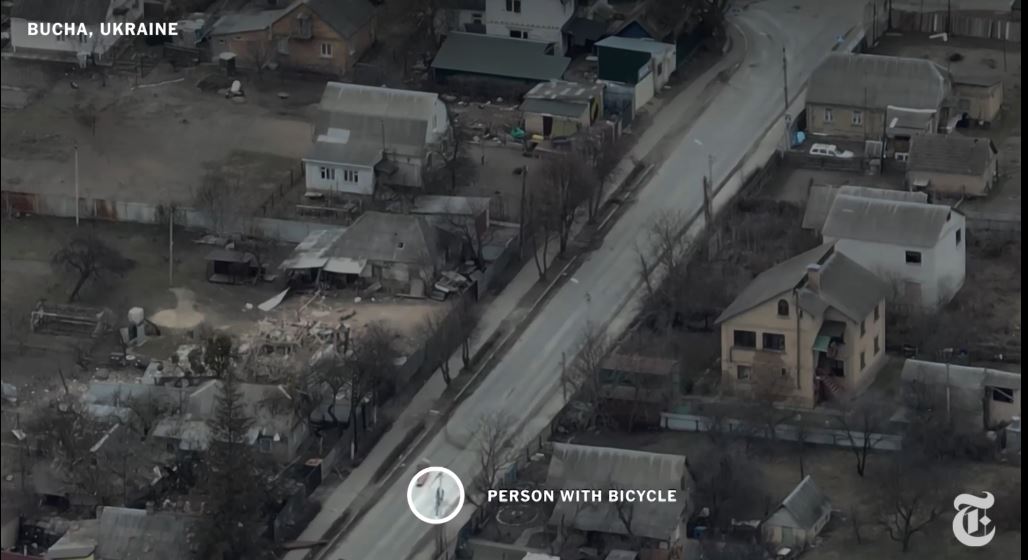
Next, introduce a sinister element to raise the drama.
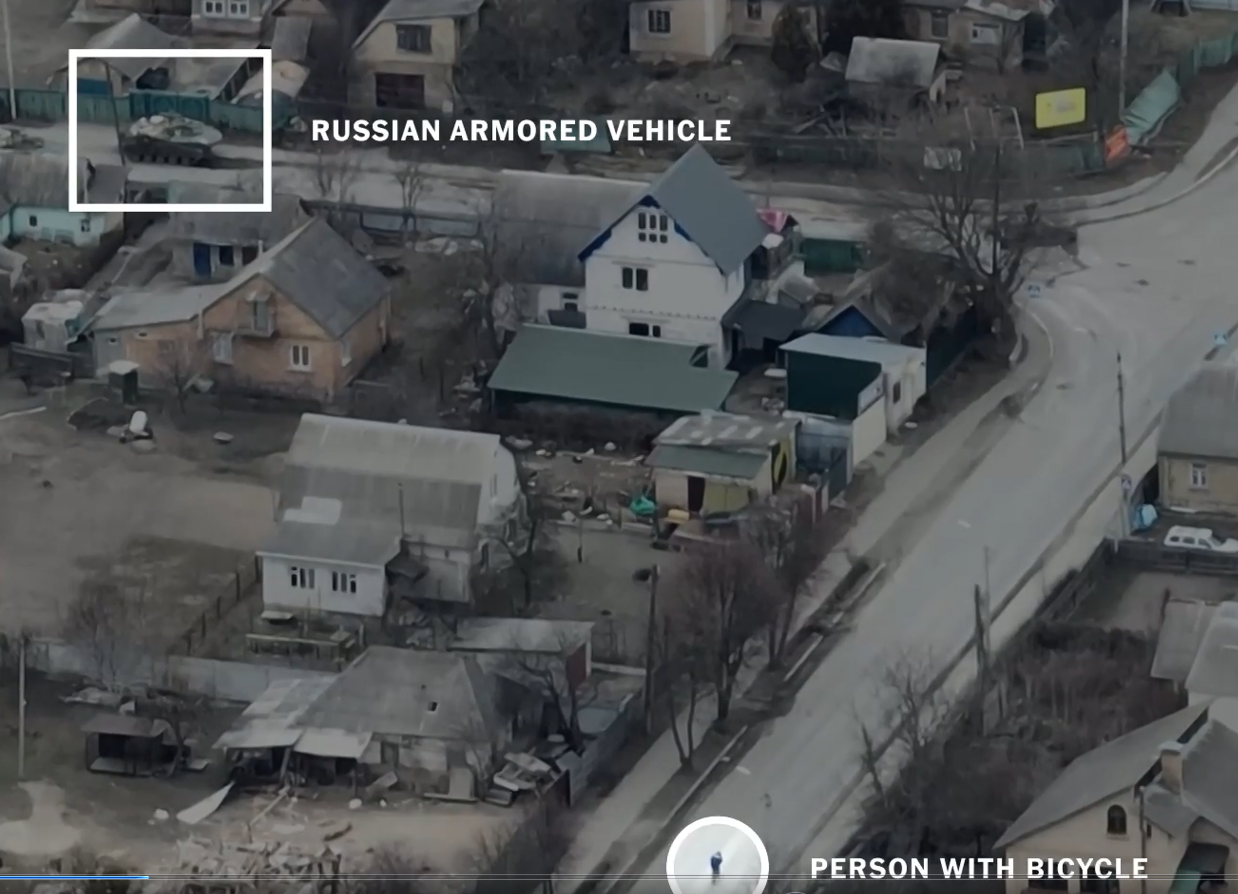
Keeping a sharp focus here is important to persuading us of the intent. Too much context might cast doubt on what we are seeing. It is ‘best’ to firm up in the viewers mind who will be the ‘goody’ and who is the ‘baddy’.
Of course, context matters, immensely. Once again, a properly developed pre-frontal cortex is asking questions to understand how this would come about. More about that later. For now, let’s stick with amygdalin fear. Empathise with the weaker party. Suspend critical thought. Magnify the fear. This is a movie.
The hero dismounts.
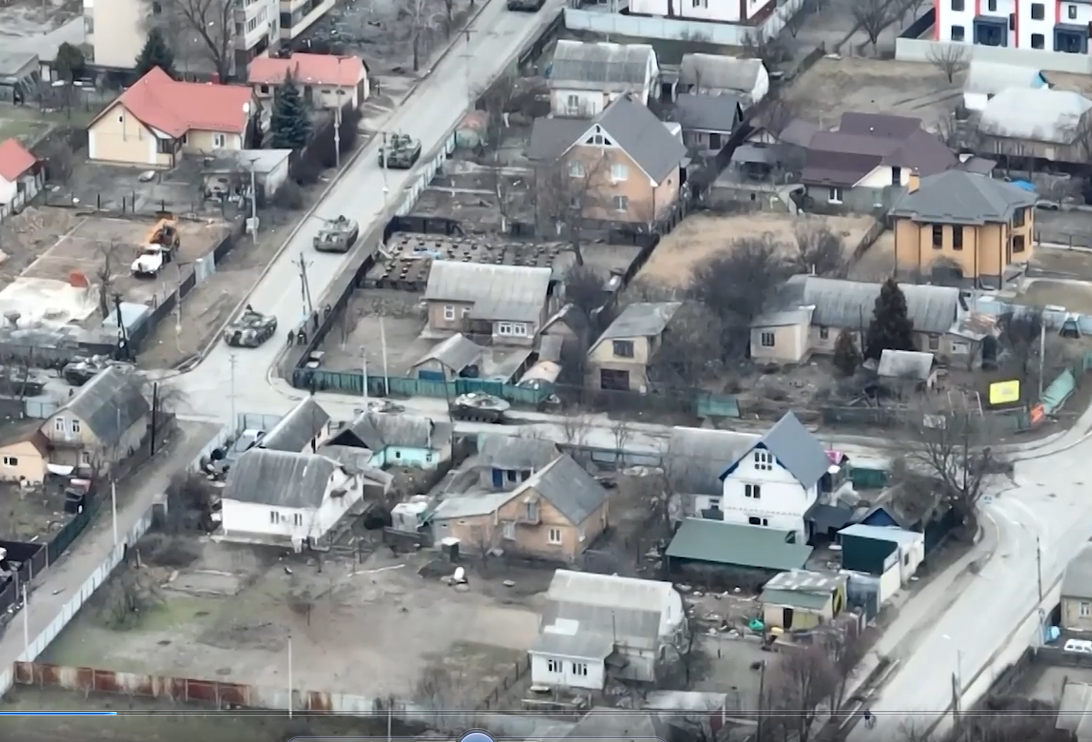 But a single tank or armoured car is not enough for dramatic effect. We must establish that this is a great force prepared to trample all before them. The tension rises. We already know the outcome. Our tiny David has collided with Goliath.
But a single tank or armoured car is not enough for dramatic effect. We must establish that this is a great force prepared to trample all before them. The tension rises. We already know the outcome. Our tiny David has collided with Goliath.
A wide shot reinforces our sense of a large force. Inadvertently, our editors show us something that adds context. Can you see it? Well, so far, the framing leads us to view this as the ‘tanks rolling in’. Is there more we should know or see? Certainly, but I’ll get to that a little later.
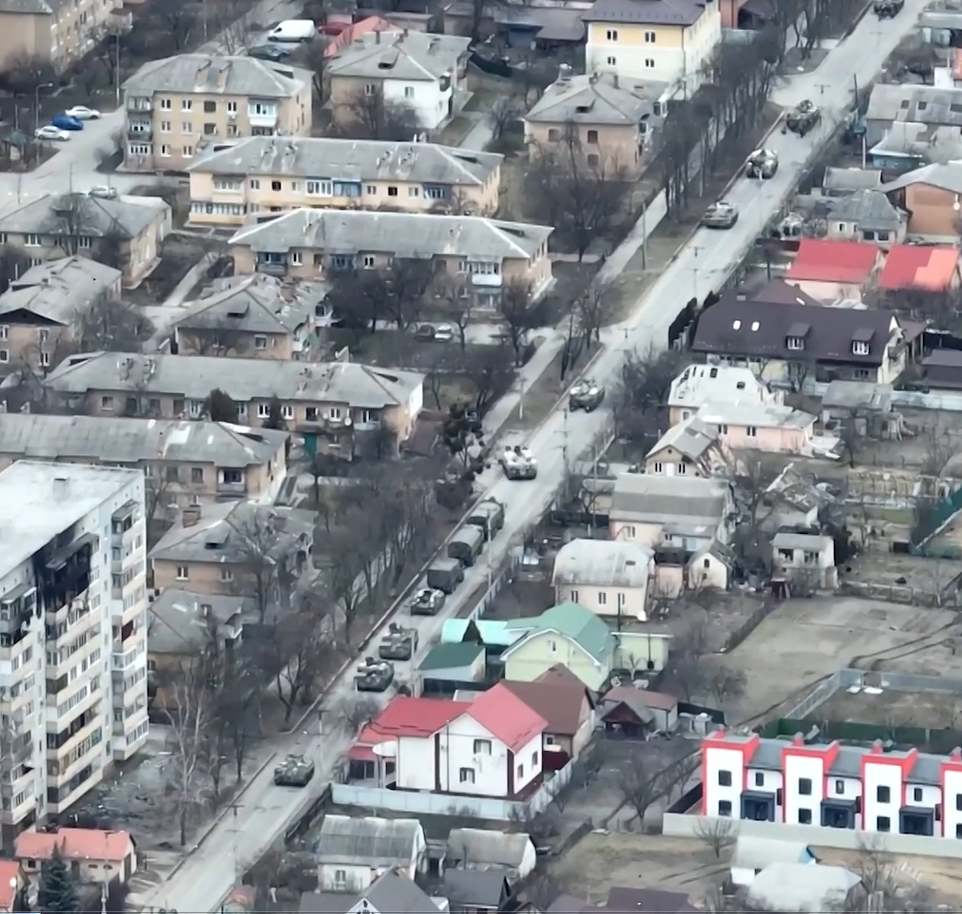 A quick cut to the action, with suitable labels, to keep our mind on the narrative. ‘Person on bicycle’ is almost certainly doomed.
A quick cut to the action, with suitable labels, to keep our mind on the narrative. ‘Person on bicycle’ is almost certainly doomed.
By holding our focus on these two participants, a neat piece of misdirection masks some of the critical elements of events in the next few seconds. I invite you to zoom in and also to freeze frame to find what the ‘magicians’ would like you to miss.
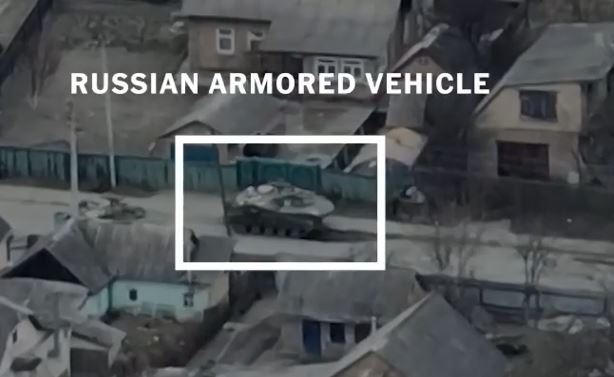
Finally, a sequence of shots suggests that the armoured vehicles ‘finished him off’.
So, returning to the first frames, let’s ask a question. We can highlight something different, like this:
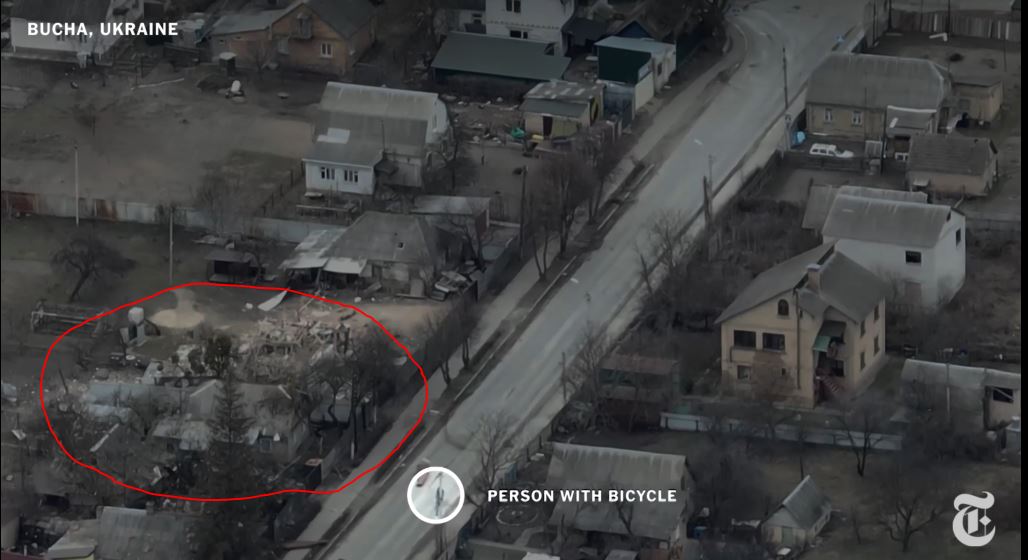
Note that houses in this street appear to have regular shapes, with similar fences. The circled area is chaotic and appears to show destruction.
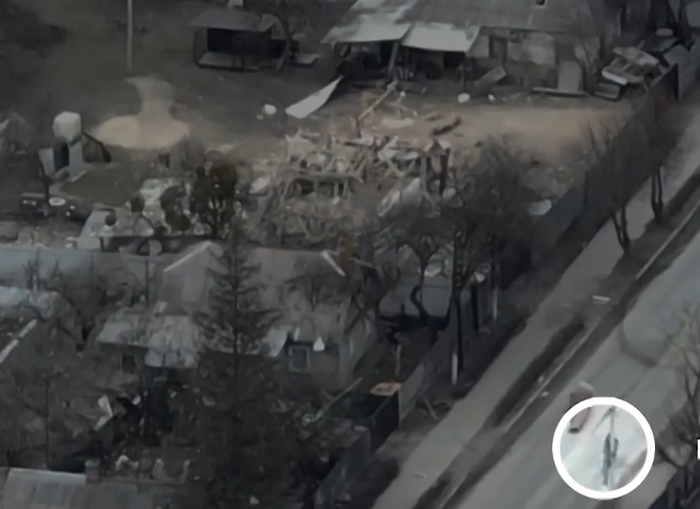
So, why is someone riding a bicycle into a warzone? What causes them to dismount? Caution? Clearly, the ‘innocent victim’ knows that there is danger, seen in the destruction that they could not avoid seeing and demonstrated by their cautious manner. Someone oblivious to the danger would simply continue riding ahead. This person is literally riding into danger. Or simply didn’t care.
And why, if the aim of Russian soldiers was to shoot civilians, did the other armoured, which actually had line of sight, not shoot?
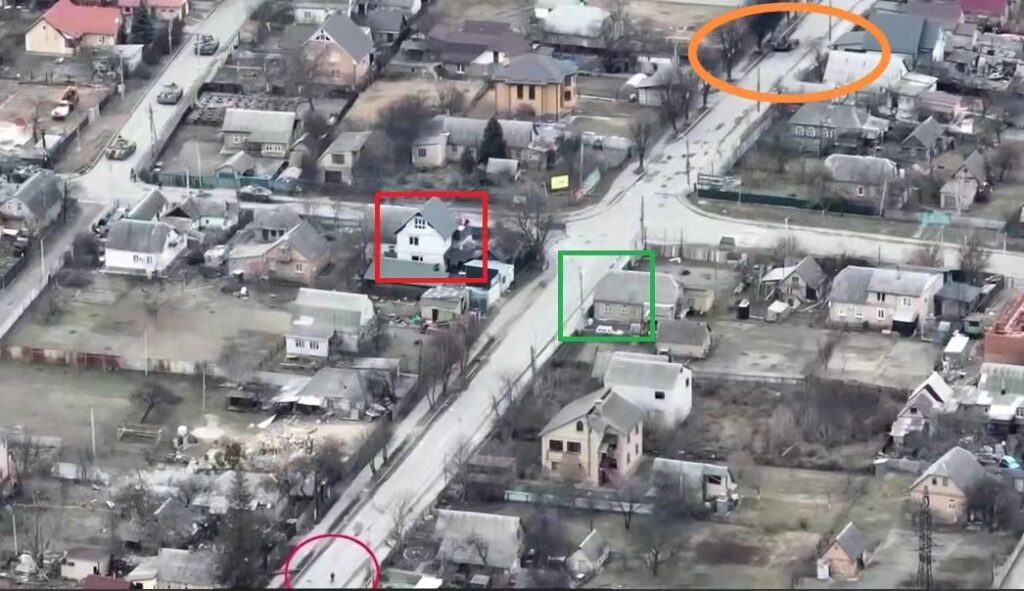
Returning to the wider shot. The NYT photo helpfully highlights the extent of the traffic, but zooming in shows that these vehicles are moving AWAY from the action (we see the rear of the vehicles). As would be normal, a rear guard is ensuring the column are not suddenly attacked from behind (the six vehicles on Yablonska Street). Almost certainly, they would be more likely to fire than any other vehicles in the column. Given the position of the drone, we can be certain that the column is moving away and that not far from the drone, Ukrainian forces are advancing or firing.
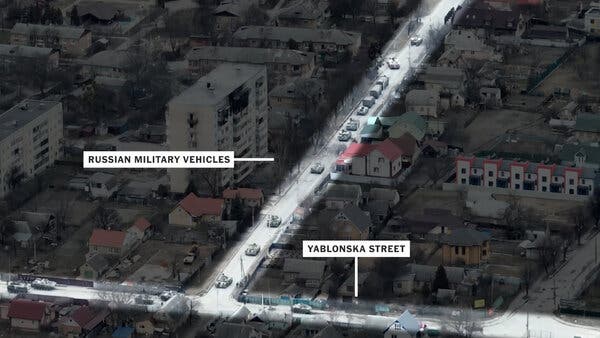
Now look closely. At 22 sec, the video cuts, so we have no continuity on the cyclist or tank and we must assume this is sequential. As we might with any good novel or movie, we are invited to join the dots.
Another cut at 26 sec returns us to the ‘action’. But something interesting happens at 29 sec. Before the cyclist rounds the corner, the armoured car fires. Here’s a video clip of it.
Incontrovertible proof that something was drawing fire before the cyclist reached the corner. The cyclist literally, clearly steps out into the line of fire!
The cyclist rounds the corner at 34 – 35 sec. Almost instantly, at 36 sec, there is another shot. Less than 1 second to identify and shoot – if indeed there is even line of sight, which is doubtful. At 38 sec, another shot – and then an unexplained pan at 39 sec returning the focus at 43 sec, once again, losing the continuity.
What happened in these 4 seconds? We simply don’t know. A cut at 48-49 sec once again throws the continuity in doubt. What might the second vehicle be shooting at now? We are simply meant to assume that it is the cyclist. But how could we possibly know?
Notably, during the passage of these events, we never see the cyclist go down.
Significantly, the NYT omits a shot that would have completed spoiled their ‘atrocity porn’. Look at this section of the video, showing clearly that the cyclist is riding directly towards a line of vehicles.
But note, having created the plot through the video, how confidently the authors can claim:

It’s a plot we are meant to swallow; hook, line and sinker. It’s clear. Russian forces brutally murdered an innocent cyclist in cold blood. From this, we can claim ‘atrocity’.
This is well crafted ‘atrocity’ propaganda, worthy of a war movie.
Now let us consider one more factor. Imagine that there was continuity and that the shot before the cyclist turned the corner did not occur. Imagine that the shot was aimed at the cyclist, perhaps by the second vehicle.
A shoulder carried anti-tank weapon can be aimed and fired inside 3 seconds. The projectile explodes above the vehicle. Everybody inside dies.
I leave you with this thought. If you suddenly saw a figure appear 50 metres away, with an ambiguous shape caused by a bicycle, and you have 3 seconds to respond before being blasted into oblivion, what would you do?